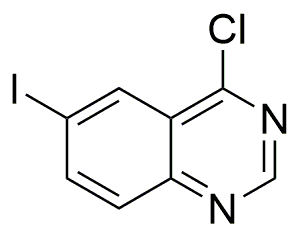4-Chloro-6-iodoquinazoline is widely utilized in research focused on:
- Pharmaceutical Development: This compound serves as a key intermediate in the synthesis of various pharmaceuticals, particularly in the development of anti-cancer agents. Its unique structure allows for modifications that enhance therapeutic efficacy.
- Biochemical Research: Researchers use it to study enzyme inhibition and receptor interactions, helping to elucidate biological pathways and mechanisms of disease.
- Agricultural Chemistry: It is explored for potential applications in developing agrochemicals, particularly as a pesticide or herbicide, due to its biological activity against certain pests.
- Material Science: The compound is investigated for its properties in creating advanced materials, such as polymers and coatings, that require specific chemical stability and reactivity.
- Diagnostic Tools: Its derivatives are being studied for use in diagnostic assays, providing a basis for the development of sensitive detection methods in clinical settings.
General Information
Properties
Safety and Regulations
Applications
4-Chloro-6-iodoquinazoline is widely utilized in research focused on:
- Pharmaceutical Development: This compound serves as a key intermediate in the synthesis of various pharmaceuticals, particularly in the development of anti-cancer agents. Its unique structure allows for modifications that enhance therapeutic efficacy.
- Biochemical Research: Researchers use it to study enzyme inhibition and receptor interactions, helping to elucidate biological pathways and mechanisms of disease.
- Agricultural Chemistry: It is explored for potential applications in developing agrochemicals, particularly as a pesticide or herbicide, due to its biological activity against certain pests.
- Material Science: The compound is investigated for its properties in creating advanced materials, such as polymers and coatings, that require specific chemical stability and reactivity.
- Diagnostic Tools: Its derivatives are being studied for use in diagnostic assays, providing a basis for the development of sensitive detection methods in clinical settings.
Documents
Safety Data Sheets (SDS)
The SDS provides comprehensive safety information on handling, storage, and disposal of the product.
Product Specification (PS)
The PS provides a comprehensive breakdown of the product’s properties, including chemical composition, physical state, purity, and storage requirements. It also details acceptable quality ranges and the product's intended applications.
Certificates of Analysis (COA)
Search for Certificates of Analysis (COA) by entering the products Lot Number. Lot and Batch Numbers can be found on a product’s label following the words ‘Lot’ or ‘Batch’.
Numéro de catalogue
Numéro de lot/série
Certificates Of Origin (COO)
This COO confirms the country where the product was manufactured, and also details the materials and components used in it and whether it is derived from natural, synthetic, or other specific sources. This certificate may be required for customs, trade, and regulatory compliance.
Numéro de catalogue
Numéro de lot/série
Safety Data Sheets (SDS)
The SDS provides comprehensive safety information on handling, storage, and disposal of the product.
DownloadProduct Specification (PS)
The PS provides a comprehensive breakdown of the product’s properties, including chemical composition, physical state, purity, and storage requirements. It also details acceptable quality ranges and the product's intended applications.
DownloadCertificates of Analysis (COA)
Search for Certificates of Analysis (COA) by entering the products Lot Number. Lot and Batch Numbers can be found on a product’s label following the words ‘Lot’ or ‘Batch’.
Numéro de catalogue
Numéro de lot/série
Certificates Of Origin (COO)
This COO confirms the country where the product was manufactured, and also details the materials and components used in it and whether it is derived from natural, synthetic, or other specific sources. This certificate may be required for customs, trade, and regulatory compliance.


